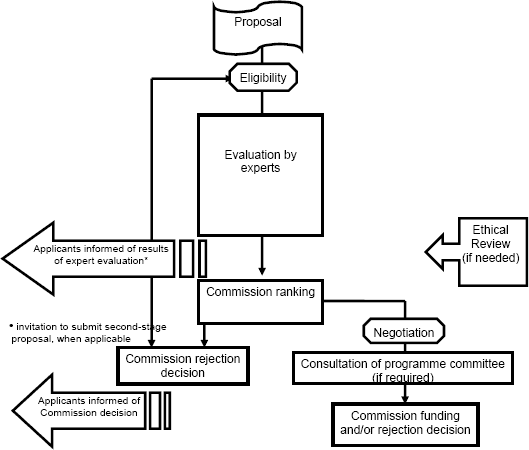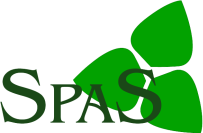Documents, Evaluation Process and Criteria, EPSS
Documents
The necessary documents related to a specific call can be found attached to the call (e.g. FP7-KBBE-2007-1 Food, Agriculture and Fisheries - http://cordis.europa.eu/fp7/dc/index.cfm?fuseaction=UserSite.CooperationDetailsCallPage&call_id=16)
Evaluation Process and Criteria
The evaluation process of the proposals is deeply organised. The funding decisions are based on peer review of research proposals. High quality evaluators are at the core of the evaluation system. The process involves 4500 to 5000 independent experts every year. About 16,000 proposals (and rising) are evaluated annually.
The evaluation process will not change from FP6 to FP7. However some criteria are new which have improved and streamlined the process:
- Clearer page limits
- Eligibility criteria (includes “scope”)
- Evaluation criteria (3 instead of 5 or 6)
- More clarity on conflicts of interest
- Enquiries and redress
The consensus on the evaluation process will be built on the basis of the individual assessments of all the evaluators
- Usually involves a discussion
- Moderated by a commission staffmember
- One expert acts as rapporteur
- Agreement on consensus marks and comments for each of the criteria
EPSS
Proposals for indirect RTD actions are invited to be submitted only as an electronic proposal via the web-based Electronic Proposal Submission System (EPSS).
All proposals for indirect RTD actions must contain two parts: the administrative forms (Part A) and the content (Part B). Proposals for indirect RTD actions must be prepared and submitted on-line. Part B of proposals for indirect RTD actions can only be submitted in PDF format (‘portable document format’, compatible with Adobe Version 3 or higher with embedded fonts). Compressed (‘zipped’) files will be excluded.
The EPSS software tool is expected to be available for this call from 19 March 2007. Proposals for indirect RTD actions that are submitted on-line and which are incomplete, illegible or contain viruses will be excluded.
Versions of proposals for indirect RTD actions submitted on a removable electronic storage medium (e.g. CD-ROM, diskette), by e-mail, or by fax will be excluded. Further details on the proposal submission procedure are given in the Guide for Applicants for the relevant call.
Tasks in a Consortium
Building a consortium
The first task for a participation in a research project will be the building of a consortium. SPAS and/or the NCP´s have a large network of contacts to the major players in European research, including the EU’s New Member States and the Associated Candidate Countries. Through these networks the company will be able to assemble suitable partners for the consortium in order to create the critical mass for achieving the project goals. They help the companies to find the right partners. Furthermore, NCP´s support the company in negotiating a consortium agreement among the partners. The company can become a partner (contribution to fulfil the tasks) or the coordinator (additionally management of the consortium) of the consortium.
Consortium Agreement
This would be obligatory, except when indicated otherwise. The new provisions on intellectual property should make is easier to conclude consortium agreements.
Dissemination, Use and Access Rights
In the area of ownership, protection, publication, dissemination and use, and access rights to background and foreground the changes are:
- removal of most of the obligations for participants to finalise conditions prior to their accession to the EC contract
- removal of most obligations to request prior approval from the EC for publication, transfers of ownership and provision of access rights to third parties, where all other partners agree.
- changes to definitions: “background” replaces “pre-existing know-how” and no longer includes side-ground and, as a consequence, “foreground” replaces “knowledge”.
Getting started
Funding decisions in the Seventh Framework Programme (FP7) are made on the basis of proposals submitted following calls published by the Commission. Proposals describe planned research activities, information on who will carry them out, and how much they will cost. They must be submitted using a special web-based service before a strictly-enforced deadline. The Commission evaluates all eligible proposals in order to identify those whose quality is sufficiently high for possible funding. The basis for this evaluation is a peer-review carried out by independent experts.
The Commission then negotiates with some or all of those whose proposals have successfully passed the evaluation stage, depending on the budget available. If negotiations are successfully concluded, grant agreements providing for an EU financial contribution are established with the participants.
The sequence of steps is summarised in this flow chart:

Participants
In most cases EU research funding through FP7 is to be sought by building a consortium in order to submit a project proposal in response to a call. The eligibility of these consortia also varies according to different conditions related to the type of action of instrument. (FUNDING SCHEMES)
Eligible Entities
At least three legal entities (defined as organisations or individual researchers) must participate in collaborative projects, each of which is established in a Member State or Associated country, and no two of which are established in the same Member State or Associated country. All three legal entities must be independent of each other in accordance with Article 6 of the RFP, meaning they are not subsidiaries of the same organisation or of each other.
For coordination and support actions, and actions in favour of training and career development of researchers, the minimum condition shall be the participation of one legal entity.
For indirect actions to support investigator-driven ‘frontier’ research projects funded in the framework of the European Research Council, the minimum condition shall be the participation of one legal entity established in a Member State or in an Associated country.
Where the minimum conditions for an indirect action are satisfied by a number of legal entities, which together form one legal entity, the latter may be the sole participant in an indirect action, provided that it is established in a Member State or Associated country. The participation of natural persons will ensure that the creation and development of scientific excellence and ability are not limited to Community funding of projects involving only legal persons, ensuring also the participation of SMEs that are not legal persons.
Eligible CountriesWhile FP7 participants can in principle be based anywhere, there are different categories of countries which may have varying eligibility for different specific and work programmes:
- MEMBER STATES - The EU-27;
- ASSOCIATED COUNTRIES – with science and technology cooperation agreements that involved contributing to the framework programme budget;(e.g. Iceland, Liechtenstein, Norway, Israel, Switzerland)
- CANDIDATE COUNTRIES – currently recognised as candidates for future accession;(e.g. Croatia, Turkey)
- THIRD COUNTRIES - the participation of organisations or individuals established in countries that are not Member States, candidates or associated should also be justified in terms of the enhanced contribution to the objectives of FP7.(e.g. Argentina, Australia, Brazil, Canada, China, Chile, Egypt, India, Korea,, Mexico, Morocco Russia, Tunisia, Ukraine, United States)
Financial contribution
Forms of grants: Three forms of grants are proposed for the Community financial contribution:
- reimbursement of eligible costs,
- lump sums, and
- flat-rate financing (the latter can be based on scale of unit costs but also includes flat rates for indirect costs).
These may be used to cover the entire Community financial contribution for a funding scheme or more than one may be used in combination.
For most funding schemes, reimbursement of eligible costs will continue to be the preferred method, particularly at the beginning of FP7. Lump sum and flat rate financing will be introduced gradually and if successful will be used more extensively.
For frontier research actions, the ERC’s Scientific Council will propose appropriate funding modalities within the terms established by the RFP and the Financial Regulation.
Reporting and reimbursement of eligible costs: The definition of eligible costs has been simplified and the three cost reporting models used in previous framework programmes have been abandoned. This means that participants can charge all their direct and indirect costs and have the option of a flat rate for indirect costs. Costs will be determined according to the usual accounting and management principles of the participants to achieve the project objectives based on principles of economy, efficiency and effectiveness.
The Community financial contribution will cover:
- a maximum of 50% of eligible costs minus receipts both for research and for demonstration activities, with a top up of a maximum of 25% for research activities for SMEs, public bodies, secondary and higher education establishments and non-profit research organisations;
- 100% of ‘frontier research’ actions for all entities.
- up to 100% for all other activities, including coordination and support actions, and training and career development of researchers, for all entities.
The maxima indicated above are applied to all eligible costs even where part of the reimbursement of costs, or even the full funding of the project, is based on lump sums or flat rates.
For Networks of Excellence, a special lump sum is proposed, with a fixed amount per researcher per year (€23,500). Portions of the lump sum would be paid periodically according to indicators showing progressive implementation of the Joint Programme of Activities (JPA).



